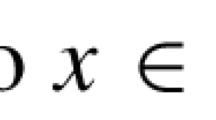Abstract
Set-valued extensions of vector-valued functions are used to investigate the relations between weak efficiency and variational inequalities (both Stampacchia and Minty type) which allows to apply the complete lattice framework from set optimization. Since the seminal work of Giannessi, it has been a challenge to generalize scalar results to the vector case. In this effort, some notions of generalized derivatives for vector-valued functions have been introduced, either in the form of set-valued functions or introducing appropriate notions of infinite elements in vector spaces. Switching the focus to set optimization in conlinear spaces, we propose a Dini-type derivative, that keeps the same set-valued form of the optimization problem.
Similar content being viewed by others
References
Ansari, Q. H., & Lee, G. M. (2010). Nonsmooth vector optimization problems and Minty vector variational inequalities. Journal of Optimization Theory and Applications, 145, 1–16.
Aubin, J.-P. (1971). A Pareto minimal principle. In H. W. Kuhn & G. P. Szegö (Eds.), Differential games and related topics (pp. 147–175). Amsterdam: North-Holland Pub. Co.
Aubin, J.-P., & Frankowska, H. (1990). Set-valued analysis, Volume 2 of systems and control: Foundations and applications. Boston: Birkhäuser Boston Inc.
Crespi, G. P., Ginchev, I., & Rocca, M. (2004a). Variational inequalities in vector optimization. In F. Giannessi & A. Maugeri (Eds.), Variational analysis and applications. Dordrecht: Kluwer Acad. Publ.
Crespi, G. P., Ginchev, I., & Rocca, M. (2004b). Minty variational inequalities, increase-along-rays property and optimization. Journal of Optimization Theory and Applications, 123(3), 479–496.
Crespi, G. P., Ginchev, I., & Rocca, M. (2006). First-order optimality conditions in set-valued optimization. Mathematical Methods of Operations Research, 63(1), 87–106.
Crespi, G. P., Ginchev, I., & Rocca, M. (2008). Some remarks on the Minty vector variational principle. Journal of Mathematical Analysis and Applications, 345(1), 165–175.
Crespi, G. P., Hamel, A. H., & Schrage, C. (2015). A Minty variational principle for set optimization. Journal of Mathematical Analysis and Applications, 423(1), 770–796.
Crespi, G. P., Rocca, M., & Schrage, C. (2015). Variational inequalities characterizing weak minimality in set optimization. Journal of Optimization Theory and Applications, 166(3), 804–824.
Crespi, G. P., & Schrage, C. (2015). Set optimization meets variational inequalities. In A. H. Art Hamel, F. Heyde, A. Löhne, B. Rudloff, & C. Schrage (Eds.), Set optimization and applications—The state of the art from set relations to set-valued risk measures (pp. 213–247). New York: Springer.
Fuchs, L. (1966). Teilweise geordnete algebraische Strukturen. Göttingen: Vandenhoeck u. Ruprecht.
Fuchssteiner, B., & Lusky, W. (1981). Convex cones, volume 56 of mathematics studies. Amsterdam: Elsevier Science Ltd.
Galatos, N. (2007). Residuated lattices: An algebraic glimpse at substructural logics. Amsterdam: Elsevier Science Ltd.
Getan, J., Martinez-Legaz, J. E., & Singer, I. (2003). (*, s)-Dualities. Journal of Mathematical Sciences, 115(4), 2506–2541.
Ginchev, I. (2007). Vector optimization problems with quasiconvex constraints. Journal of Gobal Optimization, 44, 111–130.
Giannessi, F. (1980). Theorems of the alternative, quadratic programs and complementarity problems. In R. W. Cottle, F. Giannessi, & J. L. Lions (Eds.), Variational inequalities and complementarity problems. Theory and applications (pp. 151–186). New York: Wiley.
Giannessi, F. (1997). On Minty variational principle. New trends in mathematical programming (pp. 93–99). Dordrecht: Kluwer Acad. Publ.
Giorgi, G., & Komlósi, S. (1992). Dini derivatives in optimization—Part I. Decisions in Economics and Finance, 15(1), 3–30.
Hamel, A. H. (2009). A duality theory for set-valued functions I: Fenchel conjugation theory. Set-Valued and Variational Analysis, 17(2), 153–182.
Hamel, A. H. (2005). Variational principles on metric and uniform spaces. Halle: Habilitationsschrift.
Hamel, A. H., Heyde, F., Löhne, A., Rudloff, B., & Schrage, C. (2015). Set OptimizationA rather short introduction. In A. H. Hamel, F. Heyde, A. Löhne, B. Rudloff, & C. Schrage (Eds.), Set optimization and applications—The state of the art (pp. 65–141). New York: Springer.
Hamel, A. H., & Schrage, C. (2012). Notes on extended real- and set-valued functions. Journal of Convex Analysis, 19(2), 355–384.
Hamel, A. H., & Schrage, C. (2014). Directional derivatives, subdifferentials and optimality conditions for set-valued convex functions. Pacific Journal of Optimization, 10(4), 667–684.
Hernández, E., & Rodríguez-Marín, L. (2007). Nonconvex scalarization in set optimization with set-valued maps. Journal of Mathematical Analysis and Applications, 325(1), 1–18.
Heyde, F., & Löhne, A. (2011). Solution concepts in vector optimization. A fresh look at an old story. Optimization, 60(12), 1421–1440.
Heyde, F., & Schrage, C. (2013). Continuity of set-valued maps and a fundamental duality formula for set-valued optimization. Journal of Mathematical Analysis and Applications, 397(2), 772–784.
Kuroiwa, D. (1998). The natural criteria in set-valued optimization. RIMS Kokyuroku, 1031, 85–90.
Kutateladze, S. S., & Rubinov, A. M. (1972). Minkowski duality and its applications. Russian Mathematical Surveys, 27(3), 137–191.
Löhne, A. (2011). Vector optimization with infimum and supremum. Berlin: Springer.
Luc, D. T. (1989). Theory of vector optimization. Lecture notes in economics and mathematical systems. Berlin: Springer.
Martınez-Legaz, J. E., & Singer, I. (1995). Dualities associated to binary operations on \({\bar{R}}\). Journal of Convex Analysis, 2(1–2), 185–209.
Schrage, C. (2009). Set-Valued Convex Analyis. Ph.D. Thesis, Halle.
Schrage, C. (2015). Scalar representation and conjugation of set-valued functions. Optimization, 64(2), 197–223.
Yang, X. M., Yang, X. Q., & Teo, K. L. (2004). Some remarks on the Minty vector variational inequality. Journal of Optimization Theory and Applications, 121, 193–201.
Zălinescu, C. (2002). Convex analysis in general vector spaces. River Edge: World Scientific Publishing Co., Inc.
Acknowledgements
We are thankful to the anonymous referees and their valuable suggestions that helped us to improve the paper and deepen the study, also opening new lines of research.
Author information
Authors and Affiliations
Corresponding author
Additional information
Publisher's Note
Springer Nature remains neutral with regard to jurisdictional claims in published maps and institutional affiliations.
Rights and permissions
About this article
Cite this article
Crespi, G.P., Schrage, C. Applying set optimization to weak efficiency. Ann Oper Res 296, 779–801 (2021). https://doi.org/10.1007/s10479-020-03806-2
Accepted:
Published:
Issue Date:
DOI: https://doi.org/10.1007/s10479-020-03806-2




